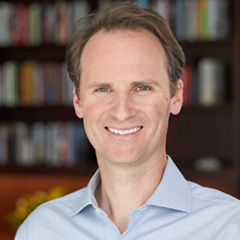
New approaches to funding local journalism can ensure diverse communities get the news that matters to them and strengthens our democracy, writes MacArthur President John Palfrey.
The business of providing local news and information is in a state of ongoing crisis. One-fifth of Americans live in news deserts. Seventy-five percent of Americans believe that people in different parties cannot agree on basic facts. Nearly 1,800 communities across the United States no longer have sufficient local news coverage from any source. Communities of color have never been well-represented in the news media, not in the newsroom and not in news coverage.
Regardless of where they live, everyone needs and deserves access to reliable, high-quality news that is consequential to their daily lives and that provides a foundation for civic participation. It is an essential building block of our democracy.
The connection between the decline of local news and the growing threats to democracy, from increasing polarization to the spread of disinformation, is well documented. American democracy is as fragile as it has ever been. At the same moment, there are extraordinary opportunities to make investments that can help rebuild a local news ecosystem that is necessary to strengthen the process of American democracy.
While philanthropic support for journalism has grown substantially over the past decade, overall charitable giving to journalism falls far short of other areas that our sector supports. In 2021, the majority of charitable dollars went to religion (27 percent), education (14 percent), human services (13 percent), grantmaking foundations (13 percent) and public-society benefit (11 percent), according to the National Philanthropic Trust.
A glance at the Chronicle of Philanthropy’s “America’s Favorite Charities 2021” does not include local news organizations anywhere near the top of the list.
Yet there are hundreds of promising new and re-energized philanthropic investment opportunities in the field of journalism that did not exist a few decades ago. Until quite recently, few saw the need for much philanthropy at all in the local news space, which was supported by a robust business model—a business model that generated huge fortunes, which in turn have helped to create major philanthropies such as the Knight, McCormick, and Annenberg foundations. One major shortcoming: the local news business has never truly reflected or been connected to the communities it is meant to serve. A new, more diverse, dynamic generation of leaders is redefining the news and media landscape.
MacArthur has long been a funder of journalism and media. Our Journalism and Media Program is one of our two Enduring Commitments, along with funding in our hometown of Chicago. We continue to believe deeply in the work we fund to strengthen democracy and build a more equitable future by informing, engaging, and activating Americans through deep investments in just and inclusive news and narratives.
In the midst of this crisis and dynamism, we have heard from many grantees and partners in the field of journalism and media that it is time to take a closer look at both the local news crisis and the new opportunities that are cropping up. Rather than relying solely upon our own expertise or a few outside experts, we decided to fund a series of organizations and researchers that have stepped forward in the past year to work on ideas related to this ongoing crisis. These grantee partners have been hosting meetings, calling in experts, and welcoming input from near and far.
As funders, we are supporting the work and listening in—and encouraging others to join us in looking afresh at this field. Some of our recent grants have supported efforts to convene and organize the field, from the Local News Summit in 2022 to the Rebuild Local News Coalition, and from the Media Power Collaborative to the Future of Local News group. These efforts are inclusive and connect the vibrant research coming out of journalism schools to help the field coalesce around solutions.
One of these efforts culminated in a meeting last week in Rancho Mirage, California, hosted by the Annenberg Foundation Trust. This gathering was an opportunity for a group of local news publishers, philanthropists, and other observers to talk about the need to bring in additional funding partners and to consider the range of exciting opportunities to fund local news innovation and sustainability across the country. The discussion was kicked off in an opening session by Nancy Gibbs, Professor of Practice at the Harvard Kennedy School and Director of the Shorenstein Center on Media, Politics, and Public Policy, who gave a sobering, illuminating overview of some of the headwinds we face in this work from her academic perch—and as one who has led a major news organization herself.
The conversation that followed was centered on a draft Roadmap for Local News. Written by Elizabeth Green of Chalkbeat (who also co-hosted the event), Darryl Holliday of City Bureau, and Mike Rispoli of Free Press, and a series of contributing co-authors. The Roadmap made three key recommendations:
- Expand the nation’s civic information ecosystem rather than “save the news business.”
- Invest in shared infrastructure for publishers.
- Support public policy that will help support local news.
The Roadmap has been shared publicly and is open for further comment and refinement. The authors welcome ongoing commentary on their findings.
MacArthur, Knight, and Annenberg are not alone in recognizing the importance of inviting others to join us in funding local news as a philanthropic effort. The Shorenstein Center recently issued a publication entitled News Crisis. One angle of this larger story: the potential role that public radio stations might play as local newspapers struggle in the new media and economic environment. The report recommends, “In addition to appeals to longstanding funders of local public radio, including governments and foundations, there’s an urgent need for a national fundraising campaign directed at major private donors who have not previously helped underwrite local public radio.”
Inspired by the Roadmap and other ongoing conversations, many of us—funders and practitioners—are working hard to meet the moment with the level of resources and ambition that is required. There is no shortage of good ideas that are ready to scale: whether it is by thinking anew about local public radio or television, new digital-only community news sites, exciting new efforts at journalism schools, or innovative new models for how to inform and engage communities.
One thing is clear: it is an opportune time to rethink how we support access to the news at the local, state, and regional levels. Those who care about the future of democracy in the United States will need to consider supporting local news organizations—in the same way that many people think about supporting their local arts and culture and other community organizations.
We need more journalists, from more diverse backgrounds, covering every community in the country for our democracy to thrive. We need community members stepping up to demand and provide this news and information for others.
Democracy requires action by individuals, families, and institutions to make it work. This crisis in local news is urgent. And there are promising pathways forward that are clearly coming into view for all to pursue.



